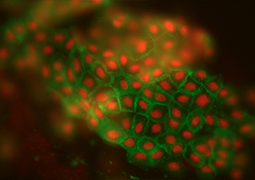Patients with dry eye syndrome form a significant proportion of those treated in everyday ophthalmology practice. Diabetes mellitus is a major risk factor for the development of dry eye syndrome. Changes in tear film homeostasis, chronic inflammation and subsequent corneal nerve fiber pathology play a key role in its progression.
The aim of this study was to describe the status of modern biomarkers of ocular surface damage in patients with type 1 diabetes and asses their utility in early diagnosis of dry eye syndrome.
Material and methods: In total the pilot study included 19 patients with type 1 diabetes (T1D) and 15 patients in the control group. All patients underwent a detailed ocular surface examination, sample collection for matrix metalloproteinase-9 (MMP-9) laboratory analysis and epithelial HLA-DR expression evaluation, and in-vivo corneal confocal microscopy.
Results: T1D patients showed statistically significantly reduced corneal nerve fiber length (p = 0.0482). The differences between the groups in terms of osmolarity, corneal sensitivity, Oxford score, tear break-up time and MMP-9 level were not statistically significant (p = 0.8272, p = 0.6029, p = 0.3507, p = 0.7561 and p = 0.0826 respectively). HLA-DR expression was examined in 10 T1D patients and 8 patients in the control group. Both groups showed minimal or no expression (p > 0.9999).
Conclusion: The previously published literature supports our finding of corneal nerve fiber length reduction in T1D patients compared to controls. However, we did not find any significant changes in standard or modern ocular surface markers (MMP-9 levels, HLA-DR expression) measured in patients with dry eye syndrome.

